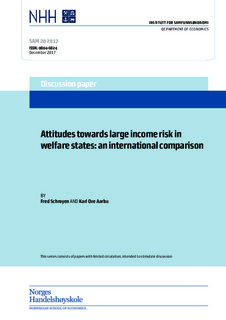| dc.contributor.author | Schroyen, Fred | |
| dc.contributor.author | Aarbu, Karl Ove | |
| dc.date.accessioned | 2017-12-18T11:36:18Z | |
| dc.date.available | 2017-12-18T11:36:18Z | |
| dc.date.issued | 2017-12 | |
| dc.identifier.issn | 0804-6824 | |
| dc.identifier.uri | http://hdl.handle.net/11250/2472440 | |
| dc.description.abstract | Using survey data and the instrument developed by Barsky et al. (1997), we estimate the distribution of attitudes towards income risk in a country where many employment and health-related risks are generously covered by a tax
financed social insurance system (Norway 2006) . Under a CRRA assumption, the sample average for the coefficient of relative risk aversion is 3.8 with a standard deviation of 2.3. This number is then contrasted to that for five other OECD countries where risk attitudes have been measured using the same instrument and also prior to the financial crisis: Chile, France, Italy, The Netherlands and the US. When we relate this distribution for stated relative risk aversion to that for generosity of social insurance and the risks related to employment and health expenditure, a picture emerges suggesting that more extensive welfare states induce higher risk tolerance for foreground risks-a- relationship that is in line with the theory on risk vulnerability. | nb_NO |
| dc.language.iso | eng | nb_NO |
| dc.publisher | Institutt for samfunnsøkonomi, NHH | nb_NO |
| dc.relation.ispartofseries | DP SAM;20/2017 | |
| dc.subject | Risk aversion; stated preferences; income lotteries; background risk; risk vulnerability; welfare state. | nb_NO |
| dc.title | Attitudes towards large income risk in welfare states: an international comparison. | nb_NO |
| dc.type | Working paper | nb_NO |
| dc.subject.nsi | VDP::Samfunnsvitenskap: 200 | nb_NO |
| dc.source.pagenumber | 56 | nb_NO |
